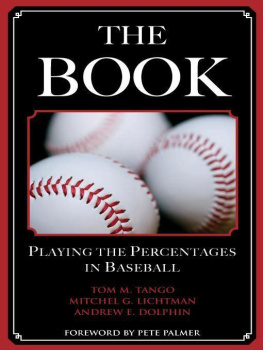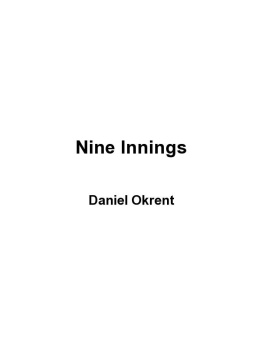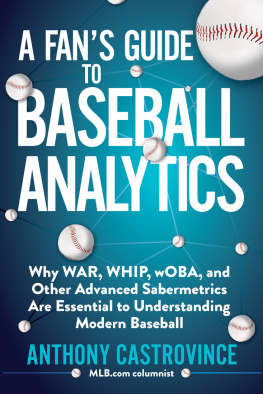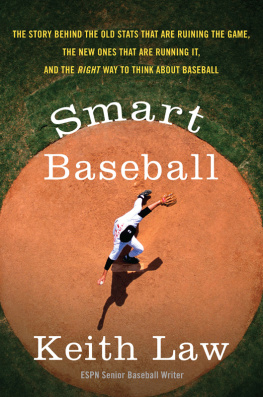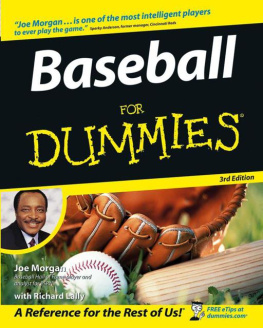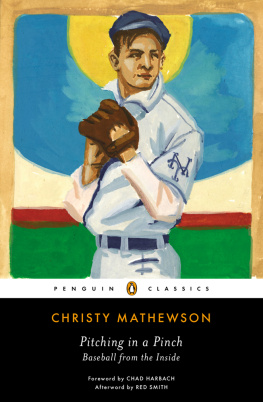Table of Contents
Other Baseball Books from Potomac Books, Inc.
The Rocket: Baseball Legend Roger Clemens ,
Joseph Janczak
Home Run: The Definitive History of Baseballs Ultimate Weapon ,
David Vincent
Deadball Stars of the American League ,
The Society for American Baseball Research, Edited by David Jones
Burying the Black Sox: How Baseballs Cover-up of the
1919 World Series Almost Succeeded ,
Gene Carney
Forging Genius: The Making of Casey Stengel ,
Steven Goldman
You Never Forget Your First:
Ballplayers Recall Their Big League Debuts,
Josh Lewin
Copyright 2007 Potomac Books, Inc.
Published in the United States by Potomac Books, Inc. All rights reserved. No part of this book may be reproduced in any manner whatsoever without written permission from the publisher, except in the case of brief quotations embodied in critical articles and reviews.
Library of Congress Cataloging-in-Publication Data
Tango, Tom M.
The book : playing the percentages in baseball / Tom M. Tango, Mitchel G.
Lichtman, Andrew E. Dolphin.1st ed.
p. cm.
Includes index.
ISBN-13: 978-1-59797-129-4 (alk. paper)
1. BaseballStatistics. I. Lichtman, Mitchel G. II. Dolphin,
Andrew E. III. Title. IV. Title: Playing the percentages in baseball.
GV877.T36 2007
796.357dc22
2007012634
Printed in the United States of America on acid-free paper that meets the
American National Standards Institute Z39-48 Standard.
Potomac Books, Inc.
22841 Quicksilver Drive
Dulles, Virginia 20166
First Edition
10 9 8 7 6 5 4 3 2 1
FOREWORD
By Pete Palmer
Back in the 1960s, when I started my baseball analysis work, there was virtually no source of play-by-play data of any kind. The data I used which ended up in The Hidden Game of Baseball in the 1980s was obtained from the play-by-play accounts of thirty-five World Series games from 1956 to 1960 in the annual Sporting News Baseball Guides. George Lindsey gathered play-by-play data from over 300 games in 1958 and 1959 and published several articles in the Journal of Operations Research in the early 1960s analyzing game strategy. Earnshaw Cooks work in the mid-1960s involved strategy and palyer evaluation and was based on simulations. Eldon and Harlan Mills commissioned the Elias Sports Bureau to produce computerized play-by-play data for 1969 and 1970 which was used for their Player Win Average calculations, a new player evaluation method. They did not tackle strategy. Unfortunately, they were ahead of their time, and their work did not catch on.
Now there are a great many play-by-play databases that are available to everyone. The whole process was kicked off by Bill James, because he had trouble getting data for his annual Baseball Abstracts in the late 1970s. Bills multitude of readers were encouraged to team up to gather and share data by scoring games at the ballpark or from radio and TV game broadcasts. This developed into Project Scoresheet in 1984.
Gary Gillette has kept the effort going until this day, first with Project Scoresheet through 1990, then with his Baseball Workshop through 1996, and now with 24-7 Baseball. Meanwhile, Dave Smith (who had helped tremendously with the last few years of Project Scoresheet) got into the act with Retrosheet in 1989. Retrosheet started to collect pre- 1984 games and now has posted almost every game back to 1960 on its website at www.retrosheet.org. Gary provided 1984-1990 games to Retrosheet from the Projects files after its demise, as well as making-available raw game stats for 1991-1998, which were the basis for the Retrosheet game logs. Dave later obtained 1991-1992 play-by-plays from STATS Inc. Retrosheet recently has also been publishing current seasons, which are now available back to 2000.
So now between Dave and Gary and the hundreds of volunteers who have contributed to Project Scoresheet and Retrosheet, we have over 45 years of games available for analysis. Dave is busy collecting games back to 1900 (and earlier), and already has hundreds of games from almost every season in the past century.
This vast source of data has permitted very detailed analysis of strategy, which Tom, Mitchel, and Andy have used to its fullest. Their analysis of the sacrifice bunt, stolen base, intentional walk, and pitchout are more thorough than any I have seen. Construction of the lineup, including platooning, and the use of starting and relief pitchers provide some fascinating results as well. There are no simple answers to the questions of strategy, but the information presented herein would be helpful for anyone actually charged with making strategic decisions, as well as being interesting to the average fan who likes to delve into these matters.
PREFACE
The biggest player on the field makes the slow walk from the on-deck circle to the batters box. The left fielder shouts out something, and the pitcher turns around. Four fingers. The left fielder, who also happens to be the coach of the team, is holding out four fingers. Half of the players on the fielding team have their mouths agape, and the other half nod approvingly. Theres a man on second base and one out, after all. The inning ends with three runs scoring, including the batter who was intentionally walked.
The left fielder/coach strides into the dugout, content he did the right thing. Then it starts.
Why did you want me to walk him?
I was playing the percentages. He was their best hitter, by far, we had first base open, and one out.
But... , the reply starts.
Its what The Book says. Well, that ends that debate, and just about every debate on this topic, ever. Once you call out the words The Book, thats it. Its gospel.
I was only the second baseman, and 19 years old at the time. What did I know? Apparently, the preachers of The Book were taught in the same manner that teenagers learn all about sex education. The Book, whether baseball or sex, is handed down generation to generation through the wisdom and experience of those more learned. It doesnt matter if any of these preachers knew anything about the topic. As long as they can claim one success somewhere, that was enough. The Book, the unwritten rules created by generation after generation of baseball followers, was gospel. The preachers did not have to quantify and qualify their reasonings, unlike every other multi-million-dollar corporation in the world.
What you are about to read is an attempt to quantify or qualify the ideal strategies in baseball. Each chapter will tackle a particular topic, and ask several very specific questions. We will use empirical data from recent MLB seasons to answer them. While we will not always have all the answers, we will at least have enough answers to make the followers better equipped to answer their own specific questions.
The unwritten Book is about to be written.
CHAPTER 1 - TOOLSHED
If youve ever read Tom Clancy or Stephen King, you know that they sometimes go into very specific technical and psychological details. You could easily skip those paragraphs and not miss a beat with the whole book. But, by reading those details, you gain an extra level of appreciation.
There are several major tools that we will be using throughout this book. In this chapter, we will introduce and describe them as completely as possible, as well as explain how they all relate to each other. Since these tools are used in some shape or form throughout the book, we find it more convenient for us (and perhaps more palatable for you) to dump/explore them here.

